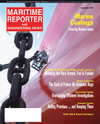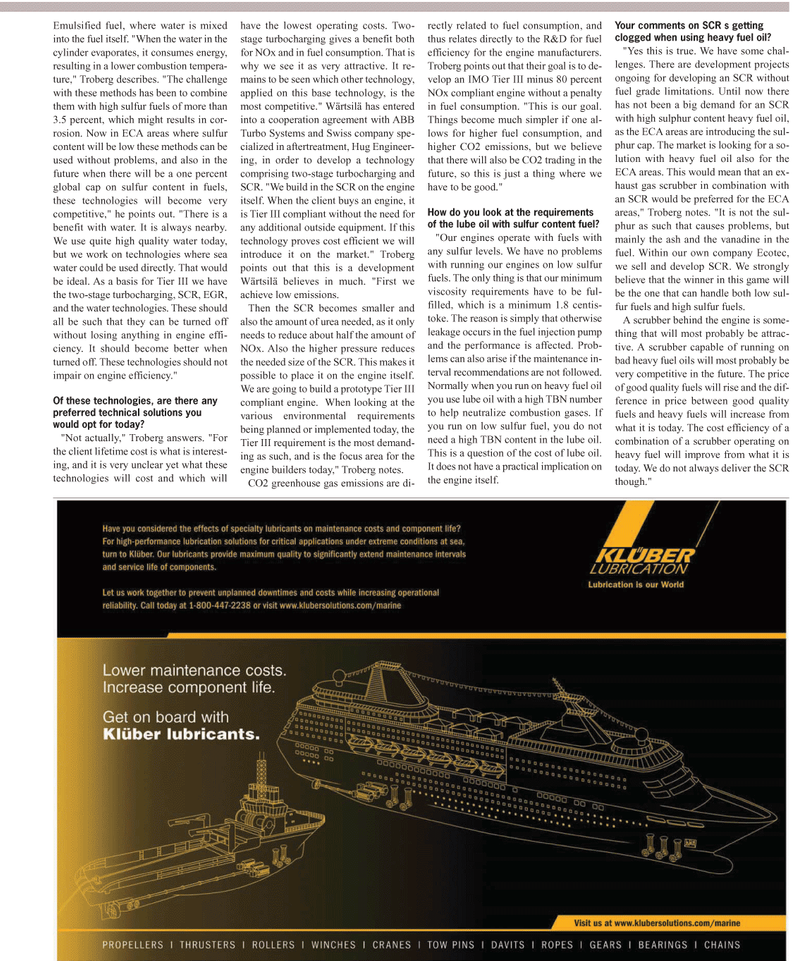
Page 33: of Maritime Reporter Magazine (September 2010)
Marine Propulsion Edition
Read this page in Pdf, Flash or Html5 edition of September 2010 Maritime Reporter Magazine
Emulsified fuel, where water is mixed into the fuel itself. "When the water in the cylinder evaporates, it consumes energy, resulting in a lower combustion tempera- ture," Troberg describes. "The challenge with these methods has been to combine them with high sulfur fuels of more than 3.5 percent, which might results in cor- rosion. Now in ECA areas where sulfur content will be low these methods can be used without problems, and also in the future when there will be a one percent global cap on sulfur content in fuels, these technologies will become very competitive," he points out. "There is a benefit with water. It is always nearby.
We use quite high quality water today, but we work on technologies where sea water could be used directly. That would be ideal. As a basis for Tier III we have the two-stage turbocharging, SCR, EGR, and the water technologies. These should all be such that they can be turned off without losing anything in engine effi- ciency. It should become better when turned off. These technologies should not impair on engine efficiency."
Of these technologies, are there any preferred technical solutions you would opt for today? "Not actually," Troberg answers. "For the client lifetime cost is what is interest- ing, and it is very unclear yet what these technologies will cost and which will have the lowest operating costs. Two- stage turbocharging gives a benefit both for NOx and in fuel consumption. That is why we see it as very attractive. It re- mains to be seen which other technology, applied on this base technology, is the most competitive." Wärtsilä has entered into a cooperation agreement with ABB
Turbo Systems and Swiss company spe- cialized in aftertreatment, Hug Engineer- ing, in order to develop a technology comprising two-stage turbocharging and
SCR. "We build in the SCR on the engine itself. When the client buys an engine, it is Tier III compliant without the need for any additional outside equipment. If this technology proves cost efficient we will introduce it on the market." Troberg points out that this is a development
Wärtsilä believes in much. "First we achieve low emissions.
Then the SCR becomes smaller and also the amount of urea needed, as it only needs to reduce about half the amount of
NOx. Also the higher pressure reduces the needed size of the SCR. This makes it possible to place it on the engine itself.
We are going to build a prototype Tier III compliant engine. When looking at the various environmental requirements being planned or implemented today, the
Tier III requirement is the most demand- ing as such, and is the focus area for the engine builders today," Troberg notes.
CO2 greenhouse gas emissions are di- rectly related to fuel consumption, and thus relates directly to the R&D for fuel efficiency for the engine manufacturers.
Troberg points out that their goal is to de- velop an IMO Tier III minus 80 percent
NOx compliant engine without a penalty in fuel consumption. "This is our goal.
Things become much simpler if one al- lows for higher fuel consumption, and higher CO2 emissions, but we believe that there will also be CO2 trading in the future, so this is just a thing where we have to be good."
How do you look at the requirements of the lube oil with sulfur content fuel? "Our engines operate with fuels with any sulfur levels. We have no problems with running our engines on low sulfur fuels. The only thing is that our minimum viscosity requirements have to be ful- filled, which is a minimum 1.8 centis- toke. The reason is simply that otherwise leakage occurs in the fuel injection pump and the performance is affected. Prob- lems can also arise if the maintenance in- terval recommendations are not followed.
Normally when you run on heavy fuel oil you use lube oil with a high TBN number to help neutralize combustion gases. If you run on low sulfur fuel, you do not need a high TBN content in the lube oil.
This is a question of the cost of lube oil.
It does not have a practical implication on the engine itself.
Your comments on SCR s getting clogged when using heavy fuel oil? "Yes this is true. We have some chal- lenges. There are development projects ongoing for developing an SCR without fuel grade limitations. Until now there has not been a big demand for an SCR with high sulphur content heavy fuel oil, as the ECA areas are introducing the sul- phur cap. The market is looking for a so- lution with heavy fuel oil also for the
ECA areas. This would mean that an ex- haust gas scrubber in combination with an SCR would be preferred for the ECA areas," Troberg notes. "It is not the sul- phur as such that causes problems, but mainly the ash and the vanadine in the fuel. Within our own company Ecotec, we sell and develop SCR. We strongly believe that the winner in this game will be the one that can handle both low sul- fur fuels and high sulfur fuels.
A scrubber behind the engine is some- thing that will most probably be attrac- tive. A scrubber capable of running on bad heavy fuel oils will most probably be very competitive in the future. The price of good quality fuels will rise and the dif- ference in price between good quality fuels and heavy fuels will increase from what it is today. The cost efficiency of a combination of a scrubber operating on heavy fuel will improve from what it is today. We do not always deliver the SCR though."

 32
32

 34
34
